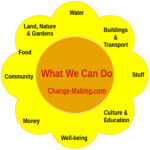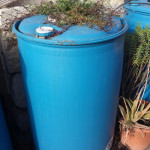The Evolving Question
My personal garden has been a grand experiment. For the first 15 or so years I dabbled at growing vegetables. At first it was about novelty: How could I stretch the tomato season? Tangy mesclun, nutty Christmas limas, and smoky salsify – what unique tastes could I bring to table? Quinoa, cassava, favas – what exotic plant varieties could I grow?
In the early days, my garden featured lots of California natives, and organic techniques simply meant more birds and butterflies. “Going organic” meant shifting from aisle 3A to aisle 3B of Home Depot. My initial vegetable-growing forays were driven by a yearning for organic food. But garden “solutions” still arrived in brightly colored packaging.
As I became a more serious environmentalist, my focus began to shift. How could I make my gardening system more sustainable with less inputs? That meant less imports from offsite, with more of what used to be “waste” reused onsite.
As our Environmental Change-Makers community group grew in popularity and morphed into the Transition Los Angeles city hub, my community-building volunteer workload increased. I wondered how to grow family-sufficient quantities of food with far less time for gardening.
I learned more about the crises looming within our petroleum-dependent agricultural system, and I became much more serious about growing food. I began to think in terms of yield and set myself to new goals as a gardener: What items could I quit buying because I had raised them at home in sufficient quantity?
In late 2007, a little church in my neighborhood took my “Obtain a Yield” rallying cry seriously. They decided to strip out a 30-year-old unused lawn and
plant a garden to grow vegetables for donation to the local food pantry. Managing the plantings for this garden – the Community Garden at Holy Nativity in the Westchester area of Los Angeles – challenged me with new questions: How does one go about producing a voluminous weekly harvest, every single week of the year?
That question quickly spawned another: How do you maintain soil fertility sufficient to support such production levels?
The answers to these questions have now become critical. Our weekly harvests from the Community Garden feed needy local families at the food bank. With the crumbling economy, food bank demand is escalating dramatically. People now count on the food coming from our harvests. Our garden simply has to produce.
Meanwhile our group is building another garden – the Emerson Avenue Community Garden. This one-acre schoolyard site once hosted an active “ag” program, which drifted into abandonment for more than a decade. We’re rebuilding it on a shoestring budget – in part because we have to, but also to explore an important issue: How can we put additional land into food production without a lot of cash or new “stuff”?
As the economic unraveling progresses over coming months and years, together with the end of cheap oil, this brief era of outsourcing our food production is drawing to a permanent close. Growing food here, locally within the city, will become survival for many people. And most of us don’t know how to produce family-sufficient yields on an ongoing and consistent basis.
It’s time to discover new ways – new ways of working within our local community and the city footprint; new ways of cooperating with the people around us; new ways of living more lightly upon the earth; new ways of thinking about ourselves (humanity) within the context of life forces on this small planet.
I found that I wasn’t the only one asking these questions. People flocked to our garden classes at the Community Garden, each with some aspect of the same question in their minds. Many people arrived as newcomers to vegetable gardening. Some stayed on to hone their skills by volunteering in the Garden. Others revisit periodically to connect with like-minded people and to swap stories about their own explorations and discoveries.
In answering these critical questions, garden books have been little help. Too many vegetable gardening books start at a very basic level – “dabbling in vegetables” – and never get so far as to answer my urgent questions about ongoing production and pushing yield.
Many vegetable gardening books are written in England or on the East Coast where gardeners quit for the winter. Their planting recommendations are completely wrong for our climate. Their pest control recommendations rely on the winter freeze to reset the life cycles of the bad bugs and weeds (meanwhile ours reproduce in happy abundance 12 months of the year). And their crop rotation ideas are completely unusable. Other books, written here in Southern California, still focus heavily on ornamentals. These authors have yet to glimpse the seriousness of the mission before us.
At the Community Gardens and in my home garden, I realize that our city gardens aren’t farms. I know that the “yield” includes something more than just food. Our gardens are simultaneously a place of respite and solace. They’re a place of natural beauty and relief from the angular harshness of city life. Amidst dancing cilantro blossoms and buzzing hoverflies and friendships forged across the fava beans, our gardens are alive.
Ultimately, it has been the school of experience and failure that has taught me, and in that regard I will admit I am still very much a learner. In this book I share what I have learned thus far with hopes it will add to your own journey. I hope it will help inform the growing body of work about sustainable urban food production, and will begin to address this nagging question of how to produce year-round abundant harvests.


